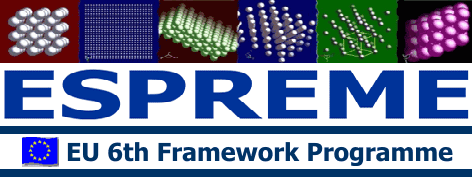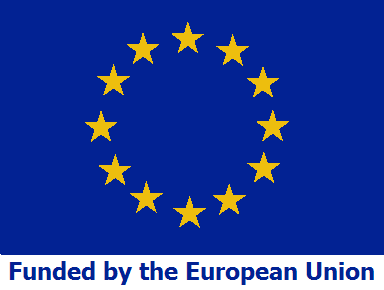ESPREME
Estimation of Willingness-to-Pay to Reduce Risks of Exposure to Heavy Metals and Coast-Benefit Analysis for Reducing Heavy Metals Occurrence in EUROPE

Finanziamento: European Commission, DG Research – 6th Framework Programme
Periodo: October 2004- October 2007
Budget totale progetto:---
Budget totale CNR IIA:---
Responsabile Scientifico: Nicola Pirrone
Abstract del progetto
The core task of the proposed project is to carry out cost-effectiveness and cost-benefit analyses for the identification of strategies to reduce impacts from the release of heavy metals into the environment in Europe.


The approach consists of the following steps:
• Consolidate, improve and provide European wide emission data of heavy metals; mercury, cadmium, lead, nickel, arsenic and chrome are taken into account.
• Collect systematic data on the possibilities to reduce emissions.
• Improve models for the transport of HM in the atmosphere, soil and water and apply them to simulate the transport of HM in these media; modelling results will be evaluated vs. measurement data.
• Collect data on thresholds and information on exposure response relationships.
• Estimate the willingness to pay to avoid damage from HM exposure by transferring values from available contingent valuation studies.
• Set up an integrated assessment model (IAM).
• Carry out runs of the IAM to identify cost effectiveness strategies, i.e. bundles of measures that achieve compliance with thresholds and cost-benefit analyses to identify bundles of measures, where the difference between benefits and costs is maximised.
• Conduct a feasibility study to identify approaches and further research needs for macro-economic assessment of HM abatement strategies.
IHigh concentrations of heavy metals (HM) in the environment (air, water and soils) has been the cause of concern for many years, as HM can have significant harmful effects on ecosystems and human health. Recent studies carried out for the EC have identified potential risks due to HM exposure of the European population and underlined the need for comprehensive policy action. In this context, it is vital for policy makers to know the options to reduce HM emissions, the impacts this will have both on HM concentrations along the full impact pathway, and finally the costs and benefits of different options, in order to establish effective and efficient measures to achieve the air quality targets for HM as identified e.g. by the World Health Organisation (WHO). To this end, a comprehensive analysis covering all key heavy metals (Hg, Pb, As, Ni, Cd and Cr), all relevant sources and their release paths through all environmental media (chemical transformation and transport, deposition to different surfaces and accumulation in water and soils) has to be carried out.
This analysis needs to comprise both a detailed assessment and compilation of state-of-the-art emission control options (technical measures as well as behavioural changes) and their costs and models and tools to conduct a sophisticated cost-benefit analysis
• Consolidate, improve and provide European wide emission data of heavy metals; mercury, cadmium, lead, nickel, arsenic and chrome are taken into account.
• Collect systematic data on the possibilities to reduce emissions.
• Improve models for the transport of HM in the atmosphere, soil and water and apply them to simulate the transport of HM in these media; modelling results will be evaluated vs. measurement data.
• Collect data on thresholds and information on exposure response relationships.
• Estimate the willingness to pay to avoid damage from HM exposure by transferring values from available contingent valuation studies.
• Set up an integrated assessment model (IAM).
• Carry out runs of the IAM to identify cost effectiveness strategies, i.e. bundles of measures that achieve compliance with thresholds and cost-benefit analyses to identify bundles of measures, where the difference between benefits and costs is maximised.
• Conduct a feasibility study to identify approaches and further research needs for macro-economic assessment of HM abatement strategies.
IHigh concentrations of heavy metals (HM) in the environment (air, water and soils) has been the cause of concern for many years, as HM can have significant harmful effects on ecosystems and human health. Recent studies carried out for the EC have identified potential risks due to HM exposure of the European population and underlined the need for comprehensive policy action. In this context, it is vital for policy makers to know the options to reduce HM emissions, the impacts this will have both on HM concentrations along the full impact pathway, and finally the costs and benefits of different options, in order to establish effective and efficient measures to achieve the air quality targets for HM as identified e.g. by the World Health Organisation (WHO). To this end, a comprehensive analysis covering all key heavy metals (Hg, Pb, As, Ni, Cd and Cr), all relevant sources and their release paths through all environmental media (chemical transformation and transport, deposition to different surfaces and accumulation in water and soils) has to be carried out.
This analysis needs to comprise both a detailed assessment and compilation of state-of-the-art emission control options (technical measures as well as behavioural changes) and their costs and models and tools to conduct a sophisticated cost-benefit analysis
The proposed project aims at the development of methods and tools to support European environmental policy making in the specific case of reducing the harmful impacts of heavy metals. Heavy Metals (in particular mercury, cadmium, chrome, nickel, lead and arsenic) from various sources contribute to ambient concentrations in air as well as to the accumulation in water and soils, thus leading to the exposure of the European population to HM levels causing a variety of adverse health effects.
As the problem spans different environmental media (air, water and soil) and at the same time has a transboundary scope due to the transport and dispersion of HM emissions to air across the hemisphere, it is vital to take a cross-media and trans-national approach. This is of particular importance, as effective policies to reduce HM emissions in a harmonised way across Europe will need to be integrated and targeted to find efficient and effective bundles of abatement measures to achieve an overall optimal policy mix. To achieve this, the proposed project will conduct an in-depth systems analysis to identify key sources, analyse and model dispersion, chemical transformation and transboundary transport with state-of-the-art models. Furthermore, by coupling chemical transport models (CTMs) with sophisticated water and soil models, the full impact pathway of HM in the environment can be assessed.
The assessment is completed by conducting cost-effectiveness and cost-benefit analyses (CEA/CBA) taking into account e.g. the willingness-to-pay of European citizens and latest findings on the quantification of external effects. In the context of the project, a feasibility study to assess macro-economic models to identify potentials for their application in the context of heavy metal abatement strategies will be carried out as well. This integrated and comprehensive assessment of the identified abatement strategies finally leads to detailed results to aid the design and implementation of European HM control strategies. In the course of the project, preliminary results as far as they are available according to the project work plan will be made available to the EC DG Environment to support the drafting of the Thematic Strategy on Air Pollution in early 2005. Approach The approach takes into account the latest research findings on pollution and impacts from heavy metals in Europe, such as the EC position papers on Ambient Air Pollution by As, Cs and Ni Compounds (Working Group On Arsenic, Cadmium And Nickel Compounds European Commission 2000) and on Ambient Air Pollution by Mercury (Working Group on Mercury European Commission 2001). Furthermore, the results of a study from ENTEC (2001) on the Economic Evaluation of Air Quality Targets for Heavy Metals are taken into consideration.
In order to assess the damage of heavy metals from their sources to environmental and health impacts in the long term, the project takes into account the accumulative, time-integrated impact of heavy metals by identifying critical loads and limits of concentration of heavy metals in different environmental media. This is done through the compilation of detailed emission inventories for all relevant heavy metals (base year 2000 and scenario for 2010), improving the quality of the current datasets in terms of resolution (temporal, spatial and substance) and accuracy, and applying the well established chemical transport model (CTM) from the EMEP MSC-E to model dispersion of HM in air and deposition to water and soils. In order to model exposure of HMs for humans, animals and plants, a sophisticated water and soil model is applied. To identify emission reduction strategies, cost-benefit (CBA) and cost-effectiveness analysis (CEA) are carried out. On the one hand, options and measures are identified to reduce the occurrence of negative impacts from environmentally or epidemiologically harmful heavy metals, the costs of their implementation and related aspects are analysed in detail, and scenarios for achieving compliance with air quality limit values for HM are designed. These abatement options are assessed as to their performance with regard to cost-effectiveness to achieve the targets, and used to evaluate abatement costs vs avoided damage costs from reduced levels of HM in a comprehensive CBA. The study is carried out for the whole of Europe, both EU Member States and Accession Countries. Within this, more detailed assessments will be conducted for individual countries by consortium members both in Western Europe (Norway, Germany, Italy) countries and in 3 Accession Countries (Poland, the Czech Republic and Hungary) so that the impact of different production and consumption patterns as well as the response of different ecological systems are understood.
The country-specific impacts will also be analysed as to their macroeconomic dimension, applying a macroeconomic model to investigate the impacts of both costs and benefits on key economic indicators (e.g. GDP, employment, health costs etc.). Approach and methodology described here advance the state-of-the-art in the context of the identification of cost-effective abatement strategies for HMs in several aspects. While both modelling and measurements of HM and studies of their adverse effects have been intensified during the last decades, the focus typically was on individual HMs, specific source groups and suchlike. Many of the projects participants have been involved in individual tasks in this context. However, recently the increasing knowledge about both the sources and processes that are responsible for the emissions of HMs as well as combined effects and interconnections between different air pollutants (e.g. particulate matter containing HMs and suchlike), a more integrated approach is needed. And in order to achieve this step towards an integrated assessment of HM, it is vital to bring together expertise in different disciplines and scopes and to establish an integrated modelling framework.
This framework needs to cover all environmental media (air, water and soil), as well as the whole of Europe in a manageable spatial resolution. In addition to that, a detailed sectoral analysis of emission sources and potential measures and options to reduce these emissions needs to be integrated with flexible and fast (parametric) models to find cost-effective (i.e. least-cost) strategies and to conduct full scale cost-benefit assessments as a basis for policy development. Finally, a comprehensive integration of technological and micro/macroeconomic approaches to account for both the effectiveness of measures (including technologies and behavioural changes) and the efficiency in terms of costs. Up to date, such an integrated framework bringing together state-of-the-art models and including latest results on the monetary valuation of damages has not been established for the assessment of heavy metal abatement. Expected outputs The expected outputs of the project are as follows: ” HM emission inventories for Europe, including QA/QC analysis of methodology and datasets as input for atmospheric and water/soil modelling for a base year (2000) and a baseline scenario for 2010.” Data sets with costs and potential of emission reduction measures ” Detailed concentration maps of HM concentrations and deposition to different surfaces and accumulation over Europe for 2000 and for a baseline scenario for 2010. ” Country specific system descriptions of the sources and impact pathways of heavy metals, compiled into databases of stock & activities as well as abatement options and their related costs for selected countries. ” Description of cost-effective policy strategies in Europe to avoid exceedences of thresholds and target values and calculation of costs and benefits for these strategies, as well as identification of optimal strategies with a full scale cost-benefit analysis. Both technological and behavioural options are considered. Detailed analyses of selected countries are added. Identification of pareto-optimal scenarios of HM reduction, where benefits outweigh costs ” Assessment of available models and databases with regard to their potentials to analyse macro-economic effects of heavy metal abatement strategies by comparing available models and databases (e.g. GEM-E3, GTAP, NEMESIS), also based on some examples of simulations, their advantages and disadvantages, and derive a detailed review (report) on state-of-the art, gaps, research needs and further work in macro-economic modelling and assessment. Intermediate results of the project as far as they are available according to the project work plan will be made available to the EC DG Environment in early 2005 to support the development of the Thematic Strategy on Air Pollution, which will be developed until mid 2005
As the problem spans different environmental media (air, water and soil) and at the same time has a transboundary scope due to the transport and dispersion of HM emissions to air across the hemisphere, it is vital to take a cross-media and trans-national approach. This is of particular importance, as effective policies to reduce HM emissions in a harmonised way across Europe will need to be integrated and targeted to find efficient and effective bundles of abatement measures to achieve an overall optimal policy mix. To achieve this, the proposed project will conduct an in-depth systems analysis to identify key sources, analyse and model dispersion, chemical transformation and transboundary transport with state-of-the-art models. Furthermore, by coupling chemical transport models (CTMs) with sophisticated water and soil models, the full impact pathway of HM in the environment can be assessed.
The assessment is completed by conducting cost-effectiveness and cost-benefit analyses (CEA/CBA) taking into account e.g. the willingness-to-pay of European citizens and latest findings on the quantification of external effects. In the context of the project, a feasibility study to assess macro-economic models to identify potentials for their application in the context of heavy metal abatement strategies will be carried out as well. This integrated and comprehensive assessment of the identified abatement strategies finally leads to detailed results to aid the design and implementation of European HM control strategies. In the course of the project, preliminary results as far as they are available according to the project work plan will be made available to the EC DG Environment to support the drafting of the Thematic Strategy on Air Pollution in early 2005. Approach The approach takes into account the latest research findings on pollution and impacts from heavy metals in Europe, such as the EC position papers on Ambient Air Pollution by As, Cs and Ni Compounds (Working Group On Arsenic, Cadmium And Nickel Compounds European Commission 2000) and on Ambient Air Pollution by Mercury (Working Group on Mercury European Commission 2001). Furthermore, the results of a study from ENTEC (2001) on the Economic Evaluation of Air Quality Targets for Heavy Metals are taken into consideration.
In order to assess the damage of heavy metals from their sources to environmental and health impacts in the long term, the project takes into account the accumulative, time-integrated impact of heavy metals by identifying critical loads and limits of concentration of heavy metals in different environmental media. This is done through the compilation of detailed emission inventories for all relevant heavy metals (base year 2000 and scenario for 2010), improving the quality of the current datasets in terms of resolution (temporal, spatial and substance) and accuracy, and applying the well established chemical transport model (CTM) from the EMEP MSC-E to model dispersion of HM in air and deposition to water and soils. In order to model exposure of HMs for humans, animals and plants, a sophisticated water and soil model is applied. To identify emission reduction strategies, cost-benefit (CBA) and cost-effectiveness analysis (CEA) are carried out. On the one hand, options and measures are identified to reduce the occurrence of negative impacts from environmentally or epidemiologically harmful heavy metals, the costs of their implementation and related aspects are analysed in detail, and scenarios for achieving compliance with air quality limit values for HM are designed. These abatement options are assessed as to their performance with regard to cost-effectiveness to achieve the targets, and used to evaluate abatement costs vs avoided damage costs from reduced levels of HM in a comprehensive CBA. The study is carried out for the whole of Europe, both EU Member States and Accession Countries. Within this, more detailed assessments will be conducted for individual countries by consortium members both in Western Europe (Norway, Germany, Italy) countries and in 3 Accession Countries (Poland, the Czech Republic and Hungary) so that the impact of different production and consumption patterns as well as the response of different ecological systems are understood.
The country-specific impacts will also be analysed as to their macroeconomic dimension, applying a macroeconomic model to investigate the impacts of both costs and benefits on key economic indicators (e.g. GDP, employment, health costs etc.). Approach and methodology described here advance the state-of-the-art in the context of the identification of cost-effective abatement strategies for HMs in several aspects. While both modelling and measurements of HM and studies of their adverse effects have been intensified during the last decades, the focus typically was on individual HMs, specific source groups and suchlike. Many of the projects participants have been involved in individual tasks in this context. However, recently the increasing knowledge about both the sources and processes that are responsible for the emissions of HMs as well as combined effects and interconnections between different air pollutants (e.g. particulate matter containing HMs and suchlike), a more integrated approach is needed. And in order to achieve this step towards an integrated assessment of HM, it is vital to bring together expertise in different disciplines and scopes and to establish an integrated modelling framework.
This framework needs to cover all environmental media (air, water and soil), as well as the whole of Europe in a manageable spatial resolution. In addition to that, a detailed sectoral analysis of emission sources and potential measures and options to reduce these emissions needs to be integrated with flexible and fast (parametric) models to find cost-effective (i.e. least-cost) strategies and to conduct full scale cost-benefit assessments as a basis for policy development. Finally, a comprehensive integration of technological and micro/macroeconomic approaches to account for both the effectiveness of measures (including technologies and behavioural changes) and the efficiency in terms of costs. Up to date, such an integrated framework bringing together state-of-the-art models and including latest results on the monetary valuation of damages has not been established for the assessment of heavy metal abatement. Expected outputs The expected outputs of the project are as follows: ” HM emission inventories for Europe, including QA/QC analysis of methodology and datasets as input for atmospheric and water/soil modelling for a base year (2000) and a baseline scenario for 2010.” Data sets with costs and potential of emission reduction measures ” Detailed concentration maps of HM concentrations and deposition to different surfaces and accumulation over Europe for 2000 and for a baseline scenario for 2010. ” Country specific system descriptions of the sources and impact pathways of heavy metals, compiled into databases of stock & activities as well as abatement options and their related costs for selected countries. ” Description of cost-effective policy strategies in Europe to avoid exceedences of thresholds and target values and calculation of costs and benefits for these strategies, as well as identification of optimal strategies with a full scale cost-benefit analysis. Both technological and behavioural options are considered. Detailed analyses of selected countries are added. Identification of pareto-optimal scenarios of HM reduction, where benefits outweigh costs ” Assessment of available models and databases with regard to their potentials to analyse macro-economic effects of heavy metal abatement strategies by comparing available models and databases (e.g. GEM-E3, GTAP, NEMESIS), also based on some examples of simulations, their advantages and disadvantages, and derive a detailed review (report) on state-of-the art, gaps, research needs and further work in macro-economic modelling and assessment. Intermediate results of the project as far as they are available according to the project work plan will be made available to the EC DG Environment in early 2005 to support the development of the Thematic Strategy on Air Pollution, which will be developed until mid 2005
• University of Stuttgart , Institute of Energy Economics and the Rational Use of Energy (USTUTT) Germany – COORDINATORE
• Norwegian Institute for Air Research (NILU) Norway
• Institute for Ecology of Industrial Areas (IETU) – Poland
• Swedish Environmental Research Institute (IVL) – Sweden
• Institute of Occupational Medicine (IOM), UK
• EMEP Meteorological Synthesizing Centre East MSC-E International
• Institute for Atmospheric Pollution (CNR-IIA) Italy
• Czech Hydrometeorological Institute CHMI Czech Republic
• ETZEL ETZEL Hungary
• NILU Polska NILU_POL Poland
• Norwegian Institute for Air Research (NILU) Norway
• Institute for Ecology of Industrial Areas (IETU) – Poland
• Swedish Environmental Research Institute (IVL) – Sweden
• Institute of Occupational Medicine (IOM), UK
• EMEP Meteorological Synthesizing Centre East MSC-E International
• Institute for Atmospheric Pollution (CNR-IIA) Italy
• Czech Hydrometeorological Institute CHMI Czech Republic
• ETZEL ETZEL Hungary
• NILU Polska NILU_POL Poland
Nicola Pirrone
Ian M. Hedgecock
Andrea Trunfio
